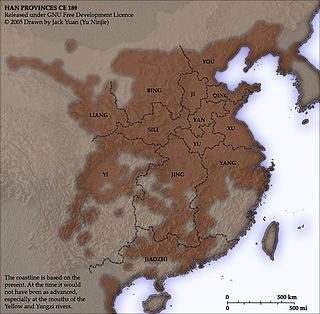The Five Barbarians, or Wu Hu, is a Chinese historical exonym for ancient non-Chinese peoples who immigrated to northern China in the Eastern Han dynasty, and then overthrew the Western Jin dynasty and established their own kingdoms in the 4th–5th centuries. The peoples categorized as the Five Barbarians were the Xiongnu, Jie, Xianbei, Di, and Qiang. Of these five tribal ethnic groups, the Xiongnu and Xianbei were nomadic peoples from the northern steppes. The ethnic identity of the Xiongnu is uncertain, but the Xianbei appear to have been Mongolic. The Jie, another pastoral people, may have been a branch of the Xiongnu, who may have been Yeniseian or Indo-Scythian. The Di and Qiang were from the highlands of western China. The Qiang were predominantly herdsmen and spoke Sino-Tibetan (Tibeto-Burman) languages, while the Di were farmers who may have spoken a Sino-Tibetan or Turkic language.

The Han Zhao, or Former Zhao, or Northern Han (北漢), was a Southern Xiongnu state during Sixteen Kingdoms period coeval with the Chinese Jin Dynasty (265-420). In the Chinese historiography it was given two conditional state titles, the Han state for the state proclaimed in 304 by Liu Yuan, and the Former Zhao state for the state proclaimed in 319 by Liu Yao. The reference to them as separate states should be considered clearly erroneous, given that when Liu Yao changed the name of the state from Han to Zhao in 319, he treated the state as having been continuous from the time that Liu Yuan founded it in 304; instead, he de-established royal lineage to the Han Dynasty and claimed ancestry directly from Yu the Great of the Xia Dynasty.

Taiyuan is the capital and largest city of Shanxi province in China. It is one of the main manufacturing bases of China. Throughout its long history, Taiyuan was the capital or provisional capital of many dynasties in China, hence the name Lóngchéng.

Yuan Shao, courtesy name Benchu, was a warlord who lived in the late Eastern Han dynasty of China. He occupied the northern territories of China during the civil wars that occurred towards the end of the Han dynasty. He was also an elder half-brother of Yuan Shu, a warlord who controlled the Huai River region, though the two were not on good terms with each other.
The grand chancellor, also translated as counselor-in-chief, chancellor, chief councillor, chief minister, imperial chancellor, lieutenant chancellor and prime minister, was the highest-ranking executive official in the imperial Chinese government. The term was known by many different names throughout Chinese history, and the exact extent of the powers associated with the position fluctuated greatly, even during a particular dynasty.

The Wuhuan were a Proto-Mongolic nomadic people who inhabited northern China, in what is now the provinces of Hebei, Liaoning, Shanxi, the municipality of Beijing and the autonomous region of Inner Mongolia.

Ju Shou was an adviser serving under the warlord Yuan Shao during the late Eastern Han dynasty of China.
Liu Yuan (劉淵), courtesy name Yuanhai (元海), formally Emperor Guangwen of Han (Zhao) was the founding emperor of the Xiongnu state Han Zhao in 308.

The Huyan was a noble house that led the last remnants of the Northern Xiongnu to Dzungaria during the second century after the Battle of the Altai Mountains. The House of Huyan is an earlier maternal lineage name subsequently replaced by Xubu, much as the Ashina and Yujiulu (郁久閭). Mongolian Khiyad tribe's name is probably derived from Huyan.

You Prefecture or Province, also known by its Chinese name Youzhou, was a prefecture (zhou) in northern China during its imperial era.
Yuzhou or Yu Province was one of the Nine Provinces of ancient China, later to become an administrative division around the reign of Emperor Wu of the Western Han dynasty.
The Chizhishizhuhou Chanyu, given name Yufuluo (於夫羅), was a puppet Chanyu of the southern Xiongnu during the late Han Dynasty period of Chinese history. In 188, he was appointed to the Chanyu position by the Chinese imperial court following the murder of his father Qiangqu, also a Han puppet from an ineligible succession line, and would later gain the Xiongnu title of Chizhisizhu.

The Han dynasty, founded by the peasant rebel leader Liu Bang, was the second imperial dynasty of China. It followed the Qin dynasty, which had unified the Warring States of China by conquest. Interrupted briefly by the Xin dynasty of Wang Mang, the Han dynasty is divided into two periods: the Western Han and the Eastern Han. These appellations are derived from the locations of the capital cities Chang'an and Luoyang, respectively. The third and final capital of the dynasty was Xuchang, where the court moved in 196 CE during a period of political turmoil and civil war.
Gao Gan, courtesy name Yuancai, was a minor warlord who lived during the late Eastern Han dynasty of China. He was a maternal nephew and subordinate of the warlord Yuan Shao.
Chunwei is an ethnonym for the most ancient nomadic tribes that invaded China during legendary times. A Chinese Classical scholar and the first President of the Imperial Nanking University, Wei Zhao (204–273), commented, identificating the name Chunwei with the name of the Huns: “During the Han they were called Xiongnu 匈奴, and the Hunyu 葷粥 is just another name for the same people, and similarly, the Xunyu 獯粥 is just another transcription of Chunwei’s 淳維, their ancestor’s name”.
Ying Shao (140-206), courtesy name Zhongyuan, was an official, writer and historian who lived during the Eastern Han dynasty of China. He was an author of the Fengsu Tongyi, an encyclopedic work about the folk customs and legends that existed in the Eastern Han dynasty. Ying Shao occupied official posts in the Han government, and in his official position he was an active participant in imperial politics. He was a long-time close associate of Cao Cao, and in that connection he was extensively covered in volumes 9, 35, 71 and 103 of the historical text Book of the Later Han.
Zhang Yang, courtesy name Zhishu, was an official and minor warlord who lived during the late Eastern Han dynasty of China. Originally from Yunzhong Commandery in the north, he eventually became the de facto ruler of Henei Commandery. Although threatened by powerful warlords such as Cao Cao and Yuan Shao, Zhang Yang still provided refuge for Emperor Xian of Han numerous times, eventually attaining the rank of Grand Marshal (大司馬).
Bingzhou or Bing Prefecture was a zhou (prefecture) in imperial China, centering on modern Taiyuan, Shanxi, China. It existed (intermittently) from the Tang dynasty until 723 and from 979 until 1059, when the Song dynasty renamed it Taiyuan Prefecture.

Dai Commandery was a commandery (jùn) of the state of Zhao established c. 300 BC and of northern imperial Chinese dynasties until the time of the Wen Emperor of the Sui dynasty. It occupied lands in what is now Hebei, Shanxi, and Inner Mongolia. Its seat was usually at Dai or Daixian, although it was moved to Gaoliu during the Eastern Han.
Chen Xi was a Chinese rebel against the first Han emperor Liu Bang.




















